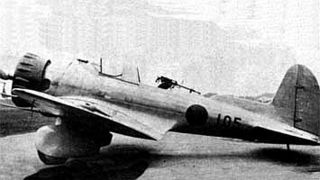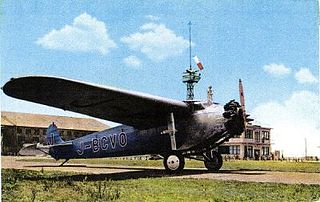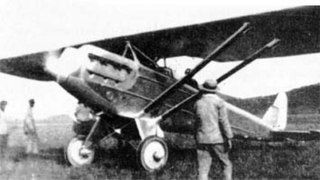
The Mitsubishi A5M, formal Japanese Navy designation Mitsubishi Navy Type 96 Carrier-based Fighter (九六式艦上戦闘機), experimental Navy designation Mitsubishi Navy Experimental 9-Shi Carrier Fighter, company designation Mitsubishi Ka-14, was a WWII-era Japanese carrier-based fighter aircraft. The Type number is from the last two digits of the Japanese imperial year 2596 (1936) when it entered service with the Imperial Navy.

The Aichi D1A or Navy Type 94/96 Carrier Bomber was a Japanese carrier-based dive bomber of the 1930s. A single-engine, two-seat biplane based on the Heinkel He 50, the D1A was produced by Aichi for the Imperial Japanese Navy, remaining in service as a trainer at the time of the attack on Pearl Harbor. The D1A was produced in two variants, the D1A1, and the D1A2.

The Nakajima A1N, or Navy Type 3 Carrier Fighter, was a Japanese carrier-based fighter of the late-1920s and early-1930s. It was a licensed copy of the British Gloster Gambet fighter, built by the Nakajima Aircraft Company for the Imperial Japanese Navy. Approximately 150 were built in two versions, the A1N1 and A1N2.

The Yokosuka B4Y was a carrier-borne torpedo bomber used by the Imperial Japanese Navy Air Service from 1936 to 1943. The B4Y replaced the Mitsubishi B2M2 and the Yokosuka B3Y, and was the last biplane bomber used operationally by the Imperial Japanese Navy. The Allied reporting name was "Jean". This aircraft was mistakenly identified by the British as the Nakajima Navy G-96.

The Nakajima E4N was a Japanese shipboard reconnaissance aircraft of the 1930s. It was a two-seat, single-engine, equal-span biplane seaplane used primarily by the Imperial Japanese Navy.

The Nakajima A2N or Navy Type 90 Carrier Fighter was a Japanese carrier-borne fighter of the 1930s. It was a single-engined biplane of mixed construction, with a fixed tailwheel undercarriage.
The Nakajima Ha1 Kotobuki was an aero-engine developed by Nakajima. It was a radial piston developed under licence from the Bristol Jupiter.

The Nakajima Ki-34 was a Japanese light transport of World War II. It was a twin-engine, low-wing monoplane; the undercarriage was of tailwheel type with retractable main units. During the Pacific War, the Allies assigned the type the reporting name Thora.

The Nakajima Ki-4Kyūyon-shiki teisatsuki (九四式偵察機) was the last biplane reconnaissance aircraft of the Japanese Imperial Army. It saw combat service in Manchukuo and in north China during the early stages of the Second Sino-Japanese War.

The Nakajima Ki-8 was an unsuccessful attempt by the Nakajima Aircraft Company to interest the Imperial Japanese Army Air Force in a two-seat modern monoplane fighter.

The Kokusai Ki-59 was an early 1940s light transport monoplane built by Nippon Kokusai Koku Kogyo K.K for the Imperial Japanese Army as a development of the Teradako-ken TK-3 which had first flown in 1938.

The Mitsubishi Ki-2 was a light bomber built by Mitsubishi for the Imperial Japanese Army Air Service (IJAAS) in the 1930s. Its Allied nickname was "Louise". Despite its antiquated appearance, the Ki-2 was successfully used in Manchukuo and in North China during the early stages of the Second Sino-Japanese War, in areas where danger from enemy fighter aircraft was minimal. It was later used in a training role.

The Nakajima Ki-6 was a licensed-produced version of the Fokker Super Universal transport built by Nakajima Aircraft Company in the 1930s. Initially used as an airliner, the militarized version was used by the Imperial Japanese Army in a variety of roles, ranging from medical evacuation to transport and training aircraft. It was used extensively in combat zones in Manchukuo and in China during the Second Sino-Japanese War.

The Mitsubishi K3M was a trainer built by Mitsubishi which was used by the Imperial Japanese Navy in an extremely wide variety of roles, including light transport, liaison aircraft, utility aircraft and occasionally light bomber. Its Allied reporting name was Pine.

The Nakajima Ki-11 was an unsuccessful attempt by Nakajima Aircraft Company to meet a 1935 requirement issued by the Japanese government for a modern single-seat monoplane fighter suitable to meet the needs of both the Imperial Japanese Army Air Force and Imperial Japanese Navy Air Service

The Mitsubishi Ki-18 was an unsuccessful and unsolicited attempt by Mitsubishi to meet a 1934 requirement issued by the Japanese Army for a modern single-seat monoplane fighter suitable to the needs of the Imperial Japanese Army Air Force. During this competition, Nakajima entered the Nakajima Ki-11, and Kawasaki entered the more maneuverable Kawasaki Ki-10 biplane. The competition was won by Kawasaki, but the new fighter was not accepted by the IJAAF with much enthusiasm.
The Yokosuka E5Y was a single-engine Japanese seaplane used for reconnaissance. The E5Y was also built by Kawanishi as the E5K
The Nakajima Ha5 is a twin row, 14 cylinder air-cooled radial aircraft engine built by the Japanese Nakajima Aircraft Company. The engine was a development of earlier single-row Japanese engines, the Kotobuki and Hikari, which had combined features of the Bristol Jupiter and Pratt & Whitney R-1340 Wasp designs.

The Kawasaki KDA-3 was a single-engine, parasol wing, single seat experimental fighter aircraft designed by Dornier engineer Dr. Richard Vogt and built by Kawasaki for the Japanese Imperial Army, first flying in 1928. The KDA-3 was built to replace the Ko-4 but only three prototypes were built and it was not ordered into production.
The Nihon L7P was a Japanese military seaplane built in World War II in the early 1940s.
















